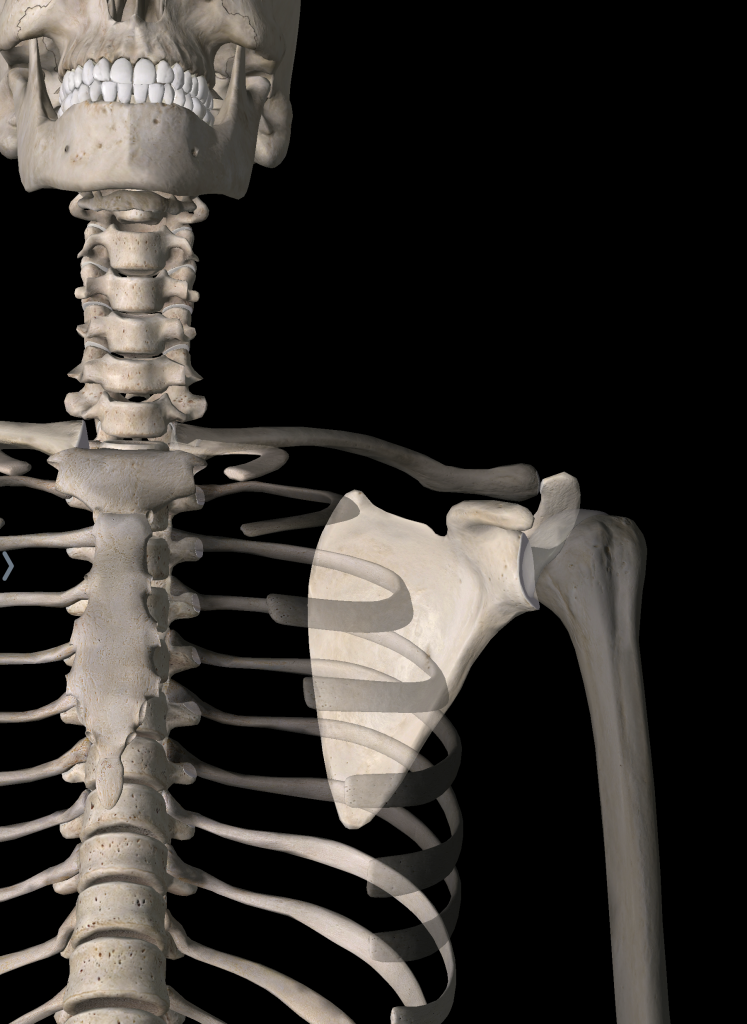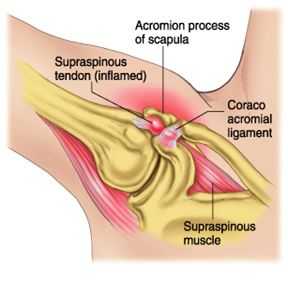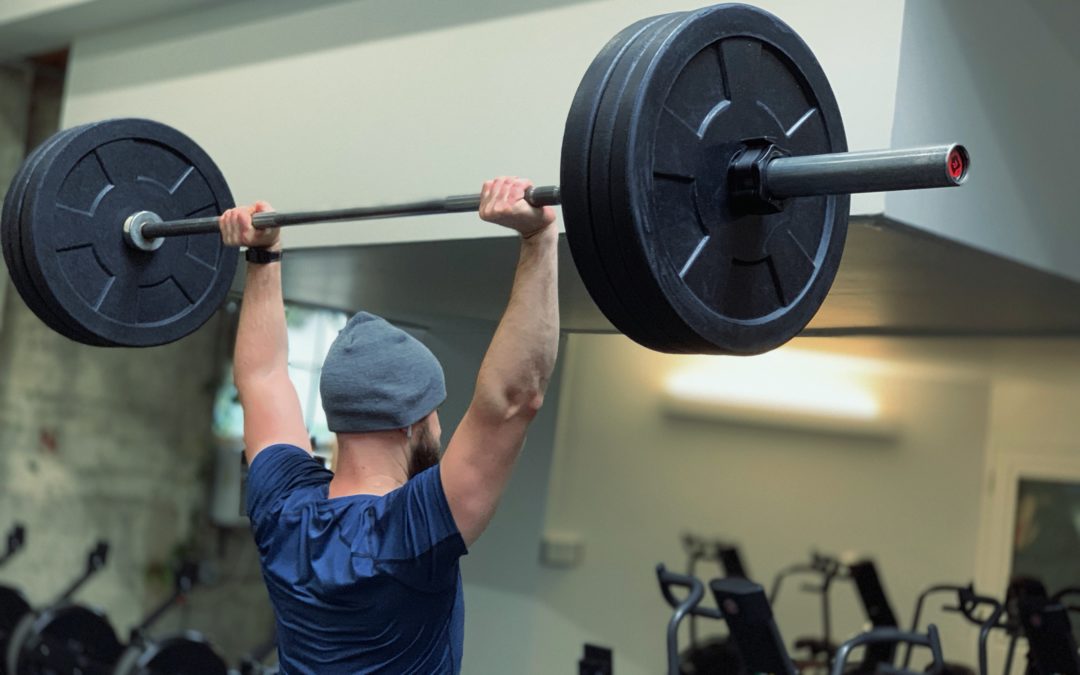Part 4 – Shoulder Pain
(Including Rotator Cuff Tears and Shoulder Impingement)
The shoulder complex is a tricky body region to picture the moving parts and understand how they are all interrelated. I find myself teaching basic shoulder anatomy and kinesiology to almost all of my shoulder patients because most people don’t understand what the shoulder actually looks like and how it is attached to the rest of the body.
I’ll kick-off this post with the same education I give my patients. First off, take a look at the pictures below. It is important to appreciate that the “ball-and-socket” joint doesn’t have much of a socket. And it is also important to appreciate how the shoulder blade has only one small boney connection to the rest of the body (the AC joint), and otherwise the entire scapula is just gliding over the ribs at the whim of the periscapular muscles that attach to it. Finally, we can see the thorax in which the shoulder blade sits on top of. This has a natural kyphosis, or forward bend, to it.



So take that third (far right) picture. Imagine that the thorax doesn’t have the ability to straighten out. You can see how this may limit the ability of the shoulder complex to perform in an overhead position. The thorax is the foundation for shoulder movement. If this are isn’t operating properly, then we can’t expect a fully functioning shoulder.
Now let’s address the second (middle) pic. This shoulder blade isn’t your typical joint. The shoulder blade can move into MANY motions; upward rotation, downward rotation, elevation, depression, abduction, adduction, external rotation, internal rotation, anterior tilt, posterior tilt, retraction, protraction, winging, and any combination of the above. With a typical presentation of shoulder impingement, the main motion that is limited is upward rotation.
And lastly, look back at the first (far left) pic. You can see the socket is actually part of the scapula. So you can imagine, in reaching overhead, the ball will roll up, and the socket should move too. If the ball moves too much with relation to the socket, you can get some nasty pinching type pains in the shoulder.
Looking at this picture below, you can see that it is the rotator cuff tendons that suffer from this as they are located in this region. If this goes untreated, this may result in a tearing of these tissues. Sometimes, people can have a tear in these tissues, and walk around without any pain or symptoms! In fact, having a rotator cuff tear that goes unnoticed is extremely common. However, the treatment should be directed towards treating the aforementioned underlying issues instead of focusing solely on the tear.

So how may conventional powerlifting training help?
Now that you have a better understanding of the injurious cascade of untreated shoulder pain. Let’s answer the question, “How can Powerlifting training be therapeutic?”
The quick answer is, powerlifting training, with correct form, will address each of the typical impairments that you see in the textbook shoulder impingement patient.
- Limited Thoracic Extension – Each lift is going to require a decent amount of thoracic extension in order to brace appropriately. Most notably, the bench press set-up requires an arch in the spine that would require reversing the thoracic kyphosis seen at the beginning of the article.
- Poor Scapular Mobility – Anyone who has performed a low-bar squat derivative can tell you that it requires every bit of scapular motion to appropriately position the bar pain free. The specific motions required here are scapular retraction and posterior scapular tilt, two commonly limited motions appreciated in those with shoulder impingement.
- Poor periscapular muscle strength – Powerlifting is all about being strong. Try and go through a decent powerlifting program and not be asked to perform and bent over row, reverse fly, band pull-apart, etc. These are staples in many powerlifting programs specifically for shoulder health and to promote balance in a sport which doesn’t have a competition lift designed around a horizontal pull.
- Poor scapular upward rotation – This impairment is the main culprit causing poor overhead mechanics and pain. However, this is remedied in powerlifting by performing the overhead press. When performed correctly, motion is derived from the scapula to drive the weight overhead, especially considering these tissues are larger and stronger combined than their counterparts that pass the shoulder and elbow. When done poorly, or poorly programmed, this exercise can be equally deleterious. Using intensities that are too high, may cause someone to learn back, and performing this exercise without the requisite range of motion is a very common instance that later results walking through my clinic doors.
How Do I Get Started?
Sold already, but don’t know where to start? No worries! I have posted directories below that will point you in the right direction so you can find skilled practitioners in your area.
Masi Fitness – If you’re local to the Charlotte Area, stop on in! I have been helping strength-sport athletes overcome various injuries and return to training and competition for over 5 years. This is including Powerlifting, Bodybuilding, Strongman, Olympic Weightlifting, Crossfit, as well as recreational and youth athletes. Feel free to peruse this blog, or download any of our e-books for some more FREE, quality, information on how to improve your lifts and ways to work around common aches and pains.
APTA Specialist Directory – This is the directory for the American Board of Physical Therapy Specialties (ABPTS). There are options to search within each specialty. An orthopedic specialist would be able to help best with nagging aches and pains and help get you back to sport specific training. A sport specialist may help you overcome, manage, or avoid injury within your sport. Some Sport Specialists have a sub-specialty with a specific sport, or set of sports.
The Clinical Athlete – This is a directory of healthcare providers that happen to be athletes themselves. Again, you can search by location and filter for specific providers. Peruse each providers website to see who is the best fit for you.
RSCC Registry – This is a directory of Strength and Conditioning Specialists that are registered with the National Strength and Conditioning Association (NSCA). This directory allows you to filter by location and search based on years of experience. Peruse this directory to find a Strength and Conditioning Specialist in your area.
Author: Dr. Michael Masi
Masi Fitness, LLC
IG: @Masi_Fitness

